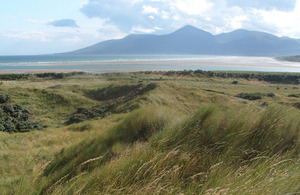Military protects rare species in Northern Ireland
A Northern Ireland training area is providing a haven for some of the most threatened species of animals and plants in the British Isles.

Coastal view of Ballykinler [Picture: Crown copyright]
Ballykinler Training Centre (BTC) supports a broad range of species groups – birds, bats, seals, moths, butterflies, plants, mosses and beetles. The site provides a refuge for important examples of populations that depend on sensitive conservation management.
Located on a headland in Dundrum Bay on Northern Ireland’s eastern coastline, BTC is situated on some 1,350 acres of stable dune systems and pasture, much of which has been now been designated as an ‘area of special scientific interest’.
The training area sits side-by-side in importance with notable wildlife sites in Northern Ireland, with neighbouring Murlough National Nature Reserve being one such example.
BTC is maintained by the Defence Infrastructure Organisation (DIO), the Ministry of Defence’s (MOD’s) property and service provider.
A DIO spokesperson said:
DIO’s priority is to support our Armed Forces as they prepare for operations. MOD has a legal obligation to deliver a sustainably-managed training estate and that means that there’s more conservation management going on at Ballykinler than you might first think.
Although we continue to develop our training facilities and areas in support of the military, we remain conscious of our responsibility to preserve our environment and heritage.
Our aim is to satisfy not only the requirements of the Army, but also the environment; and I believe that together with our partners we do this remarkably well at Ballykinler.
There is an active conservation group at Ballykinler which meets twice a year and includes representatives from MOD, the Northern Ireland Environment Agency, Ulster Wildlife, the National Trust and Butterfly Conservation, as well as several individual conservationists.
A substantial amount of time and effort goes into making Ballykinler an example of best practice in terms of conservation on an active working site:
-
a grazing regime using traditional breeds of cattle is seeing a reduction in rank grassland that in turn allows conditions suitable for a range of breeding bird species such as the meadow pipit and by definition for cuckoos
-
scrub and bracken control is being carried out that will recreate a mosaic of habitats appropriate for a range of invertebrates that will provide food for key breeding species such as the skylark, stonechat, linnet and reed bunting
-
direct action is being taken to halt the decline in barn owl numbers, a species threatened with extinction in Northern Ireland, with the provision of a dozen additional nesting sites within the estate.